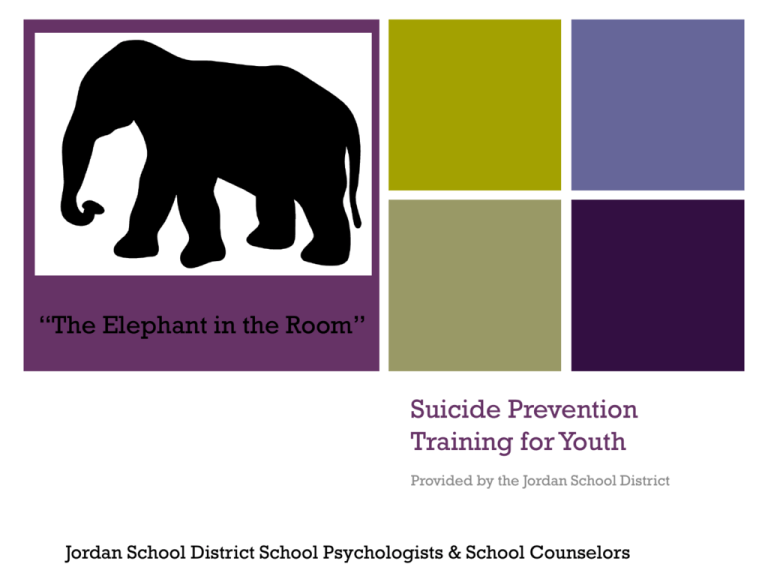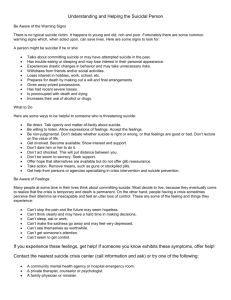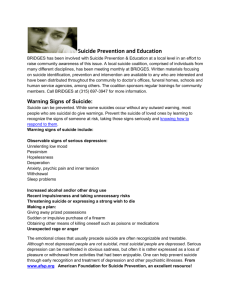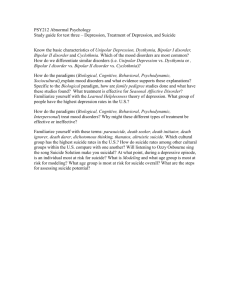Suicide Prevention 2014-2015 Handout
advertisement

“The Elephant in the Room” Suicide Prevention Training for Youth Provided by the Jordan School District Jordan School District School Psychologists & School Counselors Icebreaker Activities Elephant in the Room poem – reading activity Tennis Ball Activity Trace Yourself Activity Other Icebreaker Activities – choose one that you may have used & prefer. Emotions There are basically four primary emotions Happiness Fear Sadness Anger Stress Discussion Activity: Do kids feel stress? Which of these items listed below do you think is the number one cause of stress? 1. Too busy school schedule 2. Breakup with your girlfriend or boyfriend 3. Increased arguments with parents 4. Loss of a close friend 5. Change to a new school 6. Poor grades and trouble with school work Stress What is stress? Stress is our body’s response to demands. We all feel stress differently. How does it affect you? How do you cope with stress? What activities do you do, as a way to handle stress? Remember: Every problem has a healthy solution! 6 Sadness vs. Depression There is an important difference. We are all sad from time to time. We often might say we are “depressed” when we really mean that we are “sad.” Example: You might say, “I can’t go out with friends this weekend, so I am really depressed.” Most likely you actually mean that you are sad. Sadness vs. Depression Clinical depression Long-term— lasts longer than 2 weeks Physical (physiological) illness Affects us not only physically but mentally and emotionally too With appropriate help, it is a very treatable problem Sadness vs. Depression Depression is much more serious and intense than sadness. With depression you can possibly feel: That there is no way out of the problems you are experiencing Weak and powerless No longer enjoy doing the things that you normally like to do Have trouble concentrating Experience changes in appetite Experience changes in sleep patterns Feel like hurting yourself Remember: Every problem has a healthy solution!!! Causes of Depression Many things can cause depression. We’re going to talk about three risk factors that can cause depression, according to the DSM-5: They are as follows: 1. Temperamental 2. Environmental 2. Genetic & physiological Coping Strategies Physical activity Relaxing activity Creative activity Talking to someone you trust Structuring your day Remember: Every problem has a healthy solution!!! Who Can You Talk To When You’re Feeling Depressed Ask others for help in finding the right solution. Parent(s)/Guardian(s) Teacher/a Trusted Adult School Counselor School Psychologist Assistant Principal/Principal Coach Clergy Friend(s) *Talking with your friends is a good thing, but they may not know all of the “best” answers or solutions. Remember: Every problem has a healthy solution!!! THINK BEFORE YOU ACT! Some of us feel so overwhelmed with our problems for so long we think about ending our lives. These feelings are called suicidal thoughts. Suicide is actually ending your own life. Suicide should not be an option as it is a permanent solution to a temporary problem. It’s important to know that whatever you encounter in life, there are healthy solutions. Myths About Suicide Myths are statements that are false. The following statements are myths, i.e., they are false/not true. “People who talk about suicide never do it.” “If you discuss suicide with a suicidal person, it increases the risk that he/she will take his/her life.” “If a suicidal person shows signs of improvement, the risk is over.” “Once an individual makes a suicide attempt and fails, he/she will never try again.” Myths About Suicide “Adolescents only use the word suicide to get attention.” “Children do not understand the finality of death.” “All people who are suicidal really want to die.” “Suicide only happens to those ‘types of people’, it won’t happen to us.” Juhnke, et al., 2011 When To Ask For Help Before we can help ourselves or others, we need to know when to ask for help if we or a friend are having suicidal thoughts. Here are the warning signs: Unable to focus or think clearly Withdrawal from friends or family Changes in appearance and personality When To Ask For Help Talking, writing, or drawing about death, dying, or suicide Feelings of depression, loneliness, or isolation Talking about being a burden to others When To Ask For Help Wanting to escape a painful or a difficult situation Experiencing negative feelings Having feelings of being overwhelmed Don’t know where to go or who to turn to Can’t see a way out Remember - Every problem has a healthy solution!!! Know Who To Ask For Help You should IMMEDIATELY talk to someone if you or a friend are having suicidal thoughts: Parent(s) / Guardian(s) Teacher School Counselor School Psychologist School Assistant Principal / Principal Coach Clergy Friend(s) *Talking with your friends is a good thing, but they may not know all of the “best” answers/solutions. Remember: Every problem has a healthy solution!!! What We Can Do: Solutions for Ourselves & Others Here’s how to help someone else: Know the warning signs Calmly listen to your friend’s feelings. Make sure he or she knows how important they are to you. Make no promises or deals not to tell. Tell a trusted adult. Never keep it a secret. Don’t believe you can keep them from hurting themselves on your own. Preventing suicide always requires help from an adult. How To Help Yourself Here’s some ways to help yourself: Talk to a friend Talk to an adult Do positive, healthy things that make you feel better Be with people; try not to isolate yourself. Volunteer or become involved with service projects Surround yourself with support—parents, family, friends, a trusted adult Call a suicide hotline 1-800-273-TALK (8255) Remember: There is hope!!! You can get through this! Lower your risk Protective Factors Ties to family Good relationships with peers/adults Participation in social activities Adequate care/treatment for emotional/mental/physical health issues. A sense of spirituality Lower Your Risk Protective Factors A sense of belonging An ability to be a friend A sense of confidence, self-worth, self-esteem Lower Your Risk Protective Factors Ability to seek appropriate help or good advice Knowing how to set both short and long term goals and ways to achieve them. Having good coping skills and knowing how/when to use them. Remember: Every problem has a healthy solution!!! Putting It All Together After learning about: Risk factors Warning signs Myths How to seek help How can you lower your own risk? How can you help others? Remember: Every problem has a healthy solution!!! References American Psychological Association. Teen Suicide is Preventable. (http:www.apa.org/research/action/suicide.aspx) Brent, D.A., Poling,K.D., & Goldstein, T.R. (2011). Treating depressed and suicidal adolescents: a clinician’s guide. New York: Guilford Press. Diagnostic and Statistical Manual of Mental Disorders—Fifth Edition (DSM-5) Henderson, Christine (2011). When a Friend is Talking About Suicide. The Society for the Prevention of Teen Suicide. (website) http://sptsusa.org/teens/helpafriend.html Juhnke, G.A., Granello, D.H., & Granello, P.F. (2011). Suicide, selfinjury, and violence in the schools: assessment, prevention, and intervention strategies. New Jersey: John Wiley & Sons, Inc. References Love, A.S. (2010). When darkness comes: saying “no” to suicide. Insight Solutions, LLC. Maine Teen Suicide Prevention, “Quiz Yourself.” http://maine.gov/suicide/youth/quizyourself/index.htm National Association of School Psychologists, “Preventing Youth Suicide – Tips for Parents and Educators.” www.nasponline.org/resources/crisis_safety/suicideprevention National Institute of Mental Health. Depression. Retrieved from http://nimh.nih.gov/health/publications/depression/index.shtml# pub9 National strategy for suicide prevention: Goals and Objectives for Action. Rockville, MD: U.S. Department of Health and Human Services, Public Health Services, 2001. References Swearer, S.M., Espelage, D.L. & Napolitano, S.A. (2009). Bullying prevention & intervention: realistic strategies for schools. New York: Guilford Press. TeensHealth.org (1995-2013). Suicide. The Nemours Foundation. The Jason Foundation (Producer) (2007). A Promise for Tomorrow (Video tape). (Available from The Jason Foundation, 181 East Main Street, Suite 5, Henderson, TN 37075 Quinette, P. (1995). QPR For Suicide. QPR Institute, P.O. Box 2867, Spokane, WA 99220. Remember: Every problem has a healthy solution!!!








